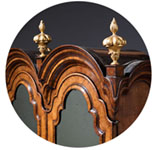17th-Century Floral Marquetry Candle Stand
Circa 1675-1690
SOLD
Request Information
Follow Us
17th-Century Floral Marquetry Candle Stand, Circa 1675-1690
In 2017 the Metropolitan Museum of Art in New York decided to auction a number of pieces of exceptional merit, too include this – IMPORTANT, exceptional, unique and extremely rare marquetry candle stand C.1675-1690.
The octagonal Paduke banded marquetry top depicts an exquisitely executed parrot to the centre, surrounded by fine spring flowers in holly, sycamore and tropical hardwoods. The vibrant green stained leaves of bone bring such vibrancy and colour to the marquetry, a detail most likely adopted from the influx of Huguenot cabinet makers in England, in the 17th century. Supported by a figured walnut six-sided tapering column, terminating on scroll legs of walnut, with original inverted walnut finial. The top is fixed to the base with its original hand-cut wooden screw thread.
Letter as received from seller – “This auction item was purchased February 19th, 2017 from our gallery at 5644 Telegraph Ave, Oakland, CA 94609 as lot 2098 in sale #581. The piece was property from the Metropolitan Museum of Art. The description and provenance details as they were listed in the February catalogue reads as follows “English walnut, ebony, satinwood and ivory occasional table, signed John Watson, circa 1700, having an octagonal top with a floral decorated border centering a parrot, above the turned standard and rising on a later tripod base, with inswept feet, 35″h x 14″dia. Property of the Metropolitan Museum of Art, Sold to Benefit the Acquisitions Fund.”
We did not believe at the time the stand was later and have authenticated the base which is period circa 1700 and original to the top. The accreditation has the backing of our colleague Jim Broughton (Chairman of the British Antique Furniture Restorers Association) and Howard Walwyn (British Antiques Dealers Association member and masterpiece dealer).
The stand has also been exhibited at vetted antiques fair Olympia, in summer 2018.
We stand by our accreditation that the stand is 100% period and original to the top.
The underside is stamped John Watson 8 N…… and we cannot make out the rest. It is most likely that John was not the maker but the once custodian of the object and adjacent is most likely an inventory stamp. There is also 11.175.10 in red, which is the museum inventory number.
Condition
The piece is in exceptional original condition with striking original colour. Minor conservation to preserve.
Provenance
Literature
English Furniture 1660-1714′, by Adam Bowett, page 121-124, 279
A table of the same period and notably similar marquetry – Adam Bowett “English Furniture 1660 -1714” Pl 4-21, which was probably supplied by the London cabinet maker Thomas Pistor to James Grahme, a friend and courtier to James, Duke of York (later James II in 1684).
Dimensions
PREVIOUSLY SOLD
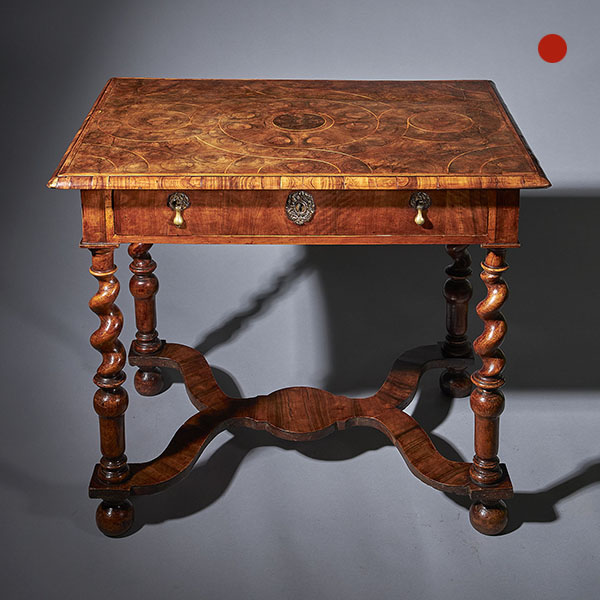
William and Mary Olive Oyster 31” Table
An exceptional and extremely rare William and Mary Olive Oyster 31” Table, Circa 1670-1690. Inlaid with holly the moulded and banded top sits above a frieze drawer, beautifully raised on original freely carved Solomonic or twist legs, terminate on reverse pears and joined by ‘y’ shaped stretcher veneered in cross-grain olive.

17th Century Charles II Olive Oyster Floral Marquetry Table, Circa 1680-1690
17th Century Charles II Olive Oyster Floral Marquetry Table, Circa 1680-1690 SoldFollow Us17th Century Charles II Olive Oyster Floral Marquetry Table, Circa 1680-1690 Floral marquetry inlaid olive oyster and ebony side table, attributed to...

18th Century George I Walnut Shepherds Crook Arm Chair with Period Needlework
18th Century George I Walnut Shepherds Crook Arm Chair with Period Needlework Sold[wpforms_selector form_id="11387" show_title="on" _builder_version="4.22.1" _module_preset="default" custom_margin="-30px||||false|false"...
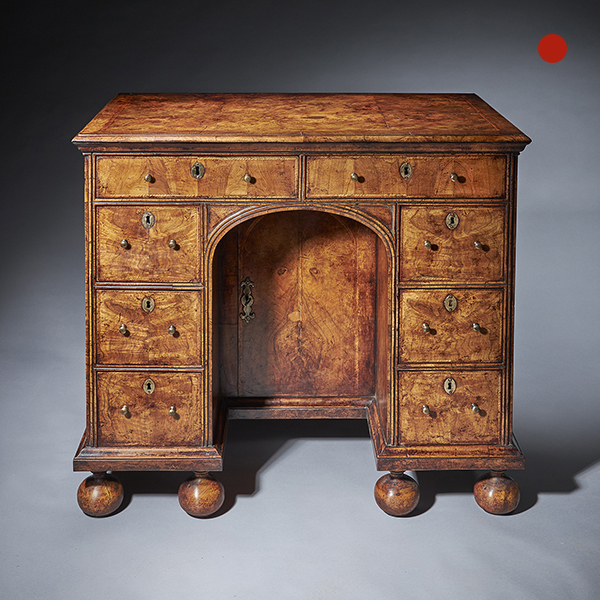
Queen Anne Walnut Kneehole Desk
The fine and rare Queen Anne (1702-1714) burr and highly figured walnut kneehole desk.
Above six solid walnut bun feet and cross-grain ogee moulding, six small drawers surround a double dee moulded edged kneehole under two long drawers
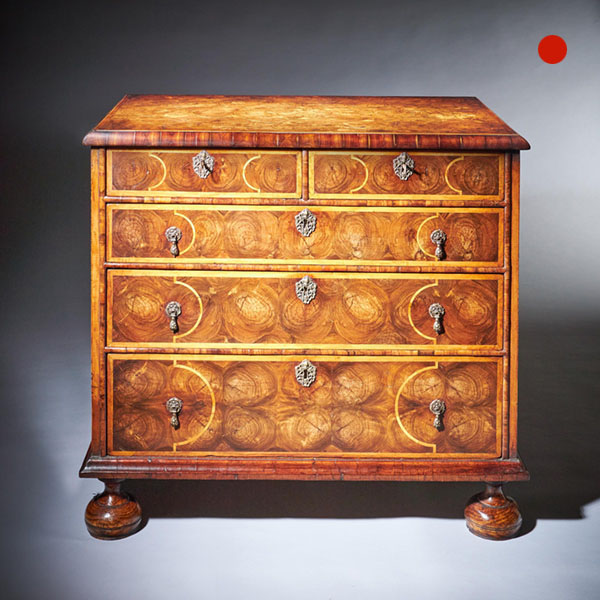
A Fine William and Mary Olive Oyster and Laburnum Chest, Circa 1680-1700
A Fine William and Mary Olive Oyster and Laburnum Chest, Circa 1680-1700 SoldFollow UsA Fine William and Mary Olive Oyster and Laburnum Chest, Circa 1680-1700 The rectangular cross-grain Laburnum moulded holly banded top is veneered in...
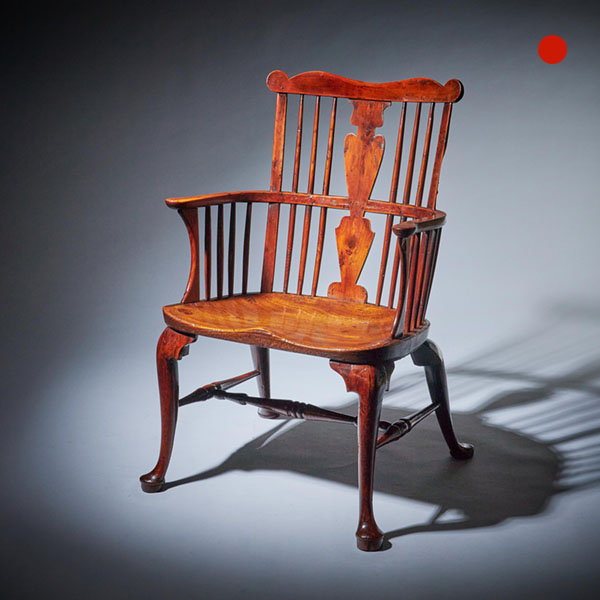
18th Century George III Yew and Elm Thames Valley Comb-Back Windsor Chair
18th Century George III Yew and Elm Thames Valley Comb-Back Windsor Chair SoldFollow Us18th Century George III Yew and Elm Thames Valley Comb-Back Windsor Chair The exceptional and rare yew and elm comb-back Regional Windsor chair of large...

William and Mary Olive Oyster 31” Table
An exceptional and extremely rare William and Mary Olive Oyster 31” Table, Circa 1670-1690. Inlaid with holly the moulded and banded top sits above a frieze drawer, beautifully raised on original freely carved Solomonic or twist legs, terminate on reverse pears and joined by ‘y’ shaped stretcher veneered in cross-grain olive.

17th Century Charles II Olive Oyster Floral Marquetry Table, Circa 1680-1690
17th Century Charles II Olive Oyster Floral Marquetry Table, Circa 1680-1690 SoldFollow Us17th Century Charles II Olive Oyster Floral Marquetry Table, Circa 1680-1690 Floral marquetry inlaid olive oyster and ebony side table, attributed to...

18th Century George I Walnut Shepherds Crook Arm Chair with Period Needlework
18th Century George I Walnut Shepherds Crook Arm Chair with Period Needlework Sold[wpforms_selector form_id="11387" show_title="on" _builder_version="4.22.1" _module_preset="default" custom_margin="-30px||||false|false"...

Queen Anne Walnut Kneehole Desk
The fine and rare Queen Anne (1702-1714) burr and highly figured walnut kneehole desk.
Above six solid walnut bun feet and cross-grain ogee moulding, six small drawers surround a double dee moulded edged kneehole under two long drawers

A Fine William and Mary Olive Oyster and Laburnum Chest, Circa 1680-1700
A Fine William and Mary Olive Oyster and Laburnum Chest, Circa 1680-1700 SoldFollow UsA Fine William and Mary Olive Oyster and Laburnum Chest, Circa 1680-1700 The rectangular cross-grain Laburnum moulded holly banded top is veneered in...

18th Century George III Yew and Elm Thames Valley Comb-Back Windsor Chair
18th Century George III Yew and Elm Thames Valley Comb-Back Windsor Chair SoldFollow Us18th Century George III Yew and Elm Thames Valley Comb-Back Windsor Chair The exceptional and rare yew and elm comb-back Regional Windsor chair of large...
YOU MAY ALSO LIKE
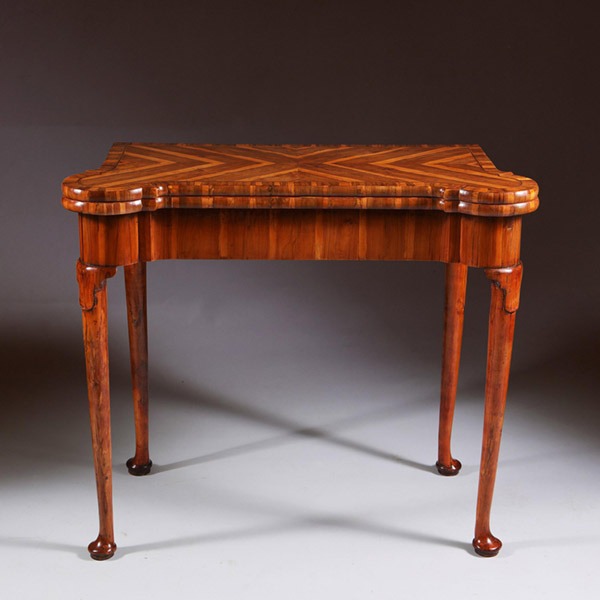
Museum Grade George I Cocus Wood Card Table, Circa 1725, England
Museum Grade George I Cocus Wood Card Table, Circa 1725. England £32,000Follow UsMuseum Grade...
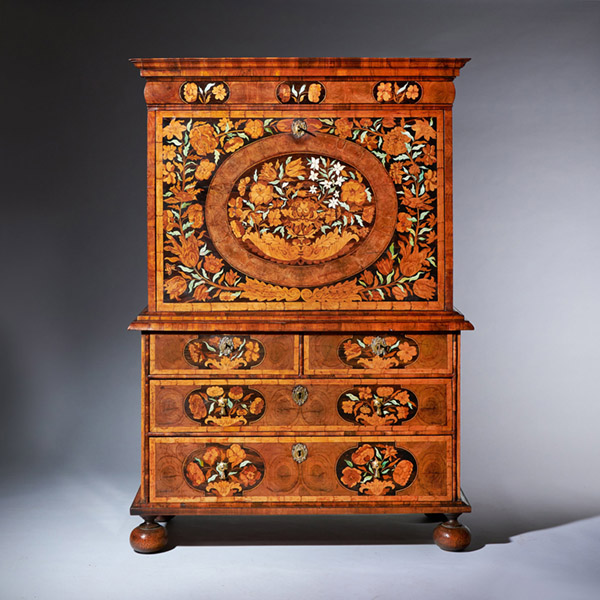
17th Century William and Mary Olive Oyster Marquetry Escritoire, Circa 1680
17th Century William and Mary Olive Oyster Marquetry Escritoire, Circa 1680 £60,000[wpforms_selector form_id="11387" show_title="on" _builder_version="4.22.1" _module_preset="default" custom_margin="-30px||||false|false"...

Fine Two-Day Marine Chronometer Signed Charles Frodsham
Fine Two-Day Marine Chronometer Signed Charles Frodsham £6,500Follow UsFine Two-Day Marine...
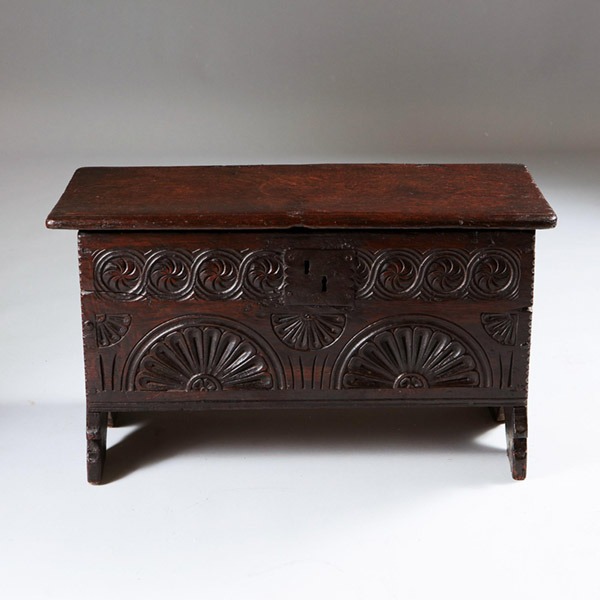
A Rare 17th Century Charles II Carved Oak Childs Coffer of Diminutive Proportion
A Rare 17th Century Charles II Carved Oak Childs Coffer of Diminutive Proportion £2,800Follow UsA...

A Rare and Important Charles II 17th Century Table Clock by Henry Jones
A Rare and Important Charles II 17th Century Table Clock by Henry Jones £85,000Follow UsA Rare and...
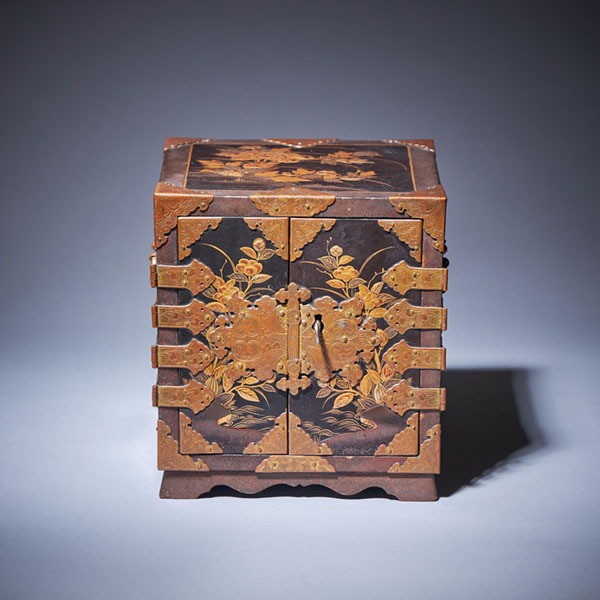
Important Early Edo Period 17th Century Miniature Japanese Lacquer Cabinet
Important Early Edo Period 17th Century Miniature Japanese Lacquer Cabinet £36,000Follow...

Museum Grade George I Cocus Wood Card Table, Circa 1725, England
Museum Grade George I Cocus Wood Card Table, Circa 1725. England £32,000Follow UsMuseum Grade...

17th Century William and Mary Olive Oyster Marquetry Escritoire, Circa 1680
17th Century William and Mary Olive Oyster Marquetry Escritoire, Circa 1680 £60,000[wpforms_selector form_id="11387" show_title="on" _builder_version="4.22.1" _module_preset="default" custom_margin="-30px||||false|false"...

Fine Two-Day Marine Chronometer Signed Charles Frodsham
Fine Two-Day Marine Chronometer Signed Charles Frodsham £6,500Follow UsFine Two-Day Marine...

A Rare 17th Century Charles II Carved Oak Childs Coffer of Diminutive Proportion
A Rare 17th Century Charles II Carved Oak Childs Coffer of Diminutive Proportion £2,800Follow UsA...

A Rare and Important Charles II 17th Century Table Clock by Henry Jones
A Rare and Important Charles II 17th Century Table Clock by Henry Jones £85,000Follow UsA Rare and...

Important Early Edo Period 17th Century Miniature Japanese Lacquer Cabinet
Important Early Edo Period 17th Century Miniature Japanese Lacquer Cabinet £36,000Follow...
